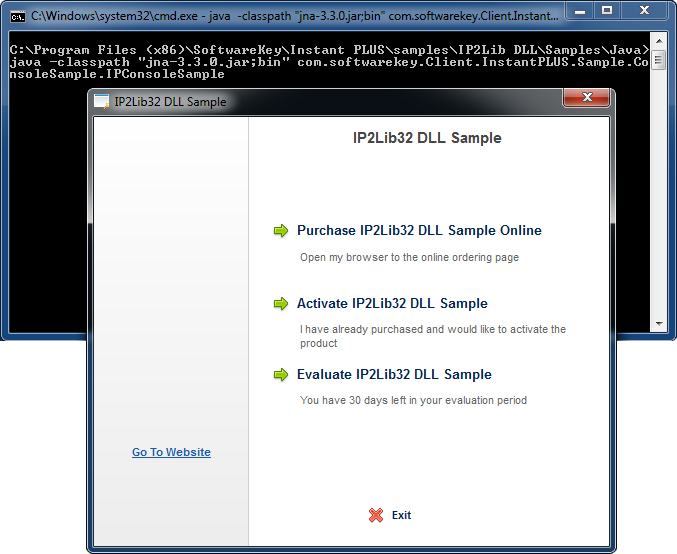
- Java jar file launch and exits zip file#
- Java jar file launch and exits driver#
- Java jar file launch and exits archive#
- Java jar file launch and exits full#
- Java jar file launch and exits code#
* A JDBC client program that inserts a row into a MySQL database.
Java jar file launch and exits code#
Here’s the package is net.codejava and the Java source file is StudentsInsert.java.Īnd below is source code of the program in the StudentsInsert.java file: package net.codejava src: contains source code which is organized in sub directories representing Java packages.Because this typically happens in Windows, I will assume you are using Windows. Let’s understand each directory in details: Answer: The information you need is in the command window (the black window), but it closes too fast for you to see it. Therefore it’s recommended to follow a common, standard directory structure as shown in the screenshot above. Organizing Directories StructureCreate the following director structure on your computer: The way you organize files is very important, as it affects the readability, maintainability and extensibility of a program when it evolves over times.
Java jar file launch and exits driver#
) ENGINE=InnoDB DEFAULT CHARSET=latin1You need to download the JDBC driver library for MySQL in order to run the program. UNIQUE KEY `student_id_UNIQUE` (`student_id`) Here’s the MySQL script to create the database: create database Students The JAR file is an executable JAR.By following this tutorial step by step, you will be able to use the three tools ( javac, jar and java) together fluently in your daily Java programming.The Java program we use in this tutorial is a JDBC client that connects to a MySQL database named Students and inserts a row into the table students. The Java source file is under a package. To see a terminal on double-click, you'd need to associate the java binary with jar files.This tutorial helps you use the core tools in JDK ( javac, jar and java) to compile, package and run a Java program under the following circumstance: Type NumberAddition in the Project Name field and specify a path, for example, in your home directory, as the project location. In the Projects pane, choose Java Application.

In the Categories pane, select the Java node. That's the binary that runs without a terminal window. Alternatively, you can click the New Project icon in the IDE toolbar. By default, javaw is normally associated to jar files. If you cannot open said window (if headless) or the user asks for it on the command line, then just default to your current behaviour.ĭouble-clicking a jar opens it with whatever application you've associated to it in your OS.
Java jar file launch and exits full#
If you want full control, you can implement a Console window in Swing which does what you have now.

I imported the sendgird 1.2.0-jar.jar in a project of mine in netbeans 8.0 (java 8) when I run SendGrid.Email email new SendGrid.Email() I got the follo.
Java jar file launch and exits zip file#
(I could do OS detection but I'm lazy and just making this so I can turn in a double-click jar file to my professor who uses windows). i downloaded the code as a zip file and run gradlew build It created 4 jar files. Designed for windows, but if you want it for another system just message me and I'll fix it. Name / location of jar file is automatic. All the files in a JAR file are compressed using a format similar to zip.

A JAR file can contain both class files and other file types like sound and image files which may be included in the project. Usage: place this class in the same package as your main class and set it as the main class, it will open a command prompt window if one is not open, or if one is open launch the main class. JAR files were designed for this purpose. Only flaw I can think of is that it leaves the cmd window open after the program completes. X: Display information about non-standard options and exit. Not sure if my answer is still relevant, but feel free to use it with the comment kept in o/ Note that JAR files that can be run with the java -jar option can have their execute. ("Program has ended, please type 'exit' to close the console") THEMAINCLASSNAMEGOESHERE.main(new String) Public static void main (String args) throws IOException, InterruptedException, URISynta圎xception) If your Ubuntu version / flavour supports it, you should be able to right click on your '.jar' files directory and click 'Open in Terminal' Type the following command: java -jar jarfilename.jar This way your '.jar' file will execute. * This opens a command line and runs some other class in the jar Once you have found the file, select it and click Ok. These attributes include digitally signing JAR files, additional compression, multiplatform compatibility, etc. JAR files are similar to zip files, but JAR files can have additional attributes that are useful for distributing Java applications.
Java jar file launch and exits archive#
Find the Java.exe file on your hard drive which is usually located within a subfolder under Program Files (x86)\Java folder or Program Files\Java folder. A JAR file is an archive file that can contain multiple files and folders.

I found this while looking for an answer myself, I ended up writing this bit: /** Go to Browse for opening the File Explorer window.


 0 kommentar(er)
0 kommentar(er)
